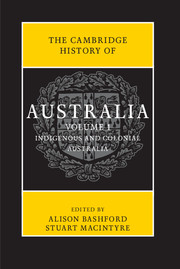Book contents
- Frontmatter
- Contents
- Abbreviations
- List of maps
- List of figures
- List of tables
- Notes on contributors
- Map
- Preface
- Introduction
- PART I
- PART II
- Further reading
- Chronology
- Index
- Frontmatter
- Contents
- Abbreviations
- List of maps
- List of figures
- List of tables
- Notes on contributors
- Map
- Preface
- Introduction
- PART I
- PART II
- 9 Religion
- 10 Culture and media
- 11 Science and medicine
- 12 Society and welfare
- 13 Gender and sexuality
- 14 Indigenous Australia
- 15 Class
- 16 The economy
- 17 Government, law and citizenship
- 18 Education
- 19 The environment
- 20 Travel and connections
- 21 Security
- 22 Australia, Britain and the British Commonwealth
- 23 Australia in the Asia-Pacfic region
- 24 The history anxiety
- Further reading
- Chronology
- Index
17 - Government, law and citizenship
from PART II
Published online by Cambridge University Press: 05 November 2013
- Frontmatter
- Contents
- Abbreviations
- List of maps
- List of figures
- List of tables
- Notes on contributors
- Map
- Preface
- Introduction
- PART I
- PART II
- Further reading
- Chronology
- Index
- Frontmatter
- Contents
- Abbreviations
- List of maps
- List of figures
- List of tables
- Notes on contributors
- Map
- Preface
- Introduction
- PART I
- PART II
- 9 Religion
- 10 Culture and media
- 11 Science and medicine
- 12 Society and welfare
- 13 Gender and sexuality
- 14 Indigenous Australia
- 15 Class
- 16 The economy
- 17 Government, law and citizenship
- 18 Education
- 19 The environment
- 20 Travel and connections
- 21 Security
- 22 Australia, Britain and the British Commonwealth
- 23 Australia in the Asia-Pacfic region
- 24 The history anxiety
- Further reading
- Chronology
- Index
Summary
There are clear trends across the fields of government, law and citizenship in twentieth-century Australia, and significant convergence in the arcs they trace. The century began with innovation, to a large extent associated with the act of Federation itself and the task of nation building. Within a decade came a lapse into stasis, accounted for by the formalisation of opposed political interests, a cultivation of traditions intended to lift justice and administration above such claims, and the settling of a policy orthodoxy aimed at ameliorating the causes that might advantage one or other of those interests. At several points – most notably in the 1940s, the 1960s and the 1980s – a surge of initiative returned, often in recognition that the balancing and bargaining points of political legitimacy had shifted.
The federal compact
The ‘people’ were remarkably active in setting the form of the new nation's government. The delegates to the conventions that framed the Constitution were popularly elected, and popular referendums were required to approve their work. Endorsed by nearly three-quarters of those who voted, the document presented to Queen Victoria in 1900 to ‘unite’ Australia's five colonies (it was a reflection of the extent of debate that Western Australia had not yet agreed to join) can be contrasted to the constitution bestowed on Canada from London in 1867. Where earlier historians emphasised the mundane economic interests weighed in the scales of Australia's prospective nationhood, recent revisionists have reclaimed the enthusiasm of the ‘people's constitution’ and the rich ‘vernacular culture’ it expressed.
Federation, then, reflected a ‘high point in Australian history’, at which belief in popular processes allowed many causes to coalesce under ‘the sovereignty of the people’ and find a place in the structures and cultures of government and law. Yet while the idea of the nation galvanised imaginations at the turn of century, it was equally and enduringly clear that the colonies-turned-States retained a resilient place.
- Type
- Chapter
- Information
- The Cambridge History of Australia , pp. 403 - 428Publisher: Cambridge University PressPrint publication year: 2013



